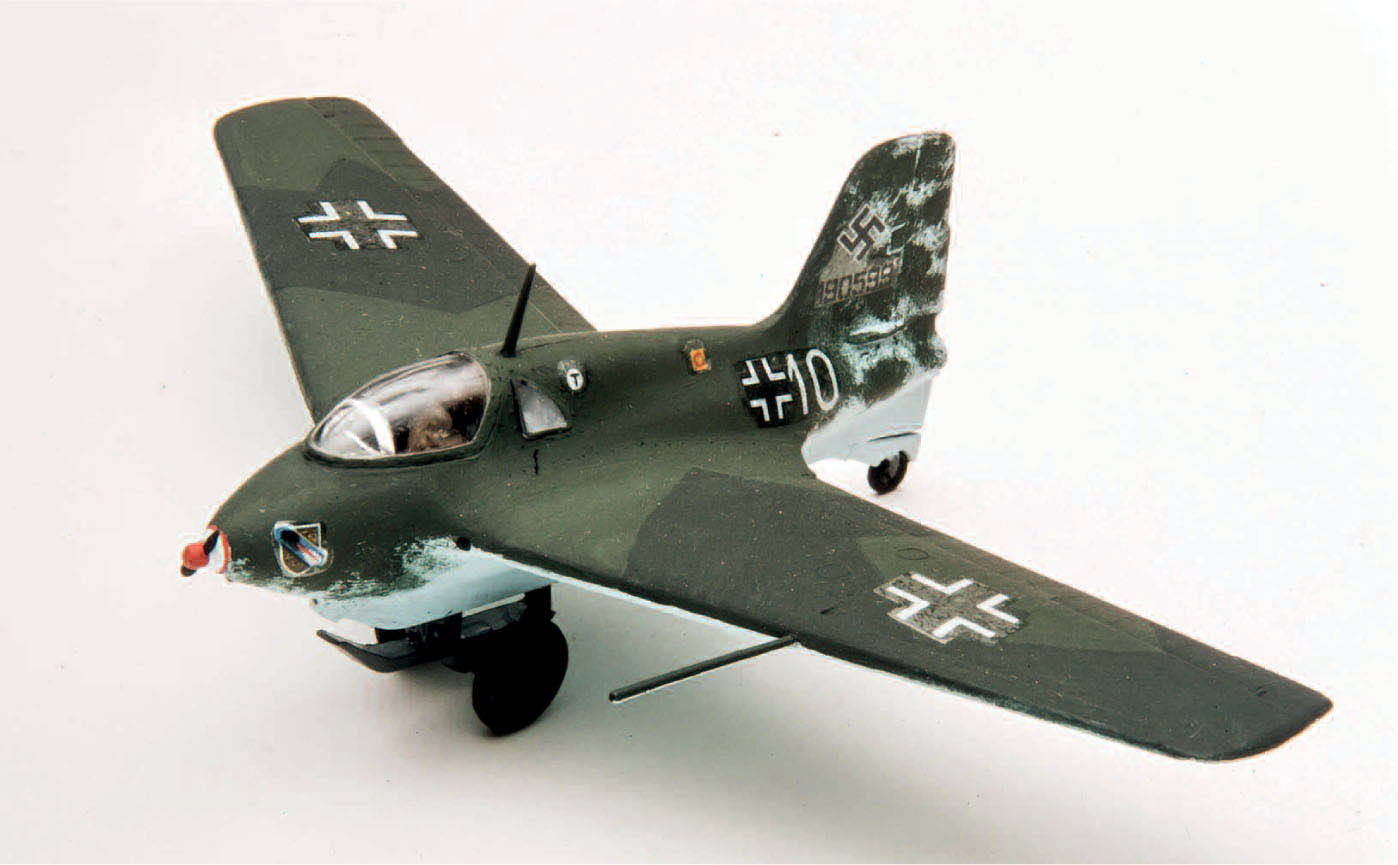
1977’s Me 163 Komet model. AIRFIX
1977
1977 was another good year, with thirty-four kits announced and thirty-three actually released:

1977’s Me 163 Komet model. AIRFIX
01063 |
Messerschmitt Me 163B Komet |
1:72 |
02062 |
Britten-Norman BN2 Defender |
1:72 |
02063 |
Focke-Wulf Fw 190A-8/F-8 |
1:72 |
02064 |
Westland Whirlwind Mk I |
1:72 |
03024 |
Westland Navy Lynx HAS Mk 2 |
1:72 |
03027 |
Douglas F4D-1 Skyray |
1:72 |
03028 |
Henschel Hs 126A1/B1 |
1:72 |
04020 |
Dornier Do 217E/J |
1:72 |
05014 |
Lockheed S-3A Viking |
1:72 |
04100 |
Supermarine Spitfire Mk Vb |
1:48 |
04101 |
Messerschmitt Bf 109F |
1:48 |
07100 |
DH Mosquito FB. VI |
1:48 |
10201 |
USS Forrestal |
1:600 |
01231 |
HMS Suffolk |
1:1200 |
02233 |
KM Prinz Eugen |
1:1200 |
09258 |
Golden Hind |
1:72 |
11481 |
Honda Road Racer |
1:8 |
08366 |
Bedford QL and Six-Pounder Gun |
1:35 |
08367 |
Chevrolet 15cwt Truck and Gun |
1:35 |
08368 |
British Field Gun Tractor |
1:35 |
07501 |
Bengal Lancer, 1901 |
1:12 |
01559 |
English Civil War Pikeman |
54mm |
01560 |
English Civil War Musketeer |
54mm |
02558 |
Roundhead/Cavalier, 1642 |
54mm |
04582 |
World War II German Infantry |
1:32 |
04583 |
World War II US Marines |
1:32 |
04584 |
World War II Japanese Infantry |
1:32 |
03831 |
Blue Tits |
1:1 |
03800 |
Tyrannosaurus Rex |
N/A |
03801 |
Triceratops |
N/A |
51471 |
World War II Gurkhas |
1:32 |
51473 |
Modern German Infantry |
1:32 |
04381 |
Jungle Headquarters |
1:76 |
01732 |
World War II British Commandos |
1:76 |
With the exception of the three ex-MAX 1:35 AFVs and the ex-MPC motorcycle, all the releases were Airfix moulds.
The Messerschmitt Komet was a neat little model of the late war German rocket-propelled interceptor. It has not featured in the range in the last few years, however, and the mould tool was on display in the Hornby Visitor’s Centre until displayed at RAF Hendon in the Airfix Box Art Exhibition, in 2013.
The Defender and Do 217 were minor modifications of existing kits, and the Navy Lynx was the second of the new Lynx kits. All have featured recently in the catalogue and the Lynx has been upgraded to the latest HMA.8 standard.
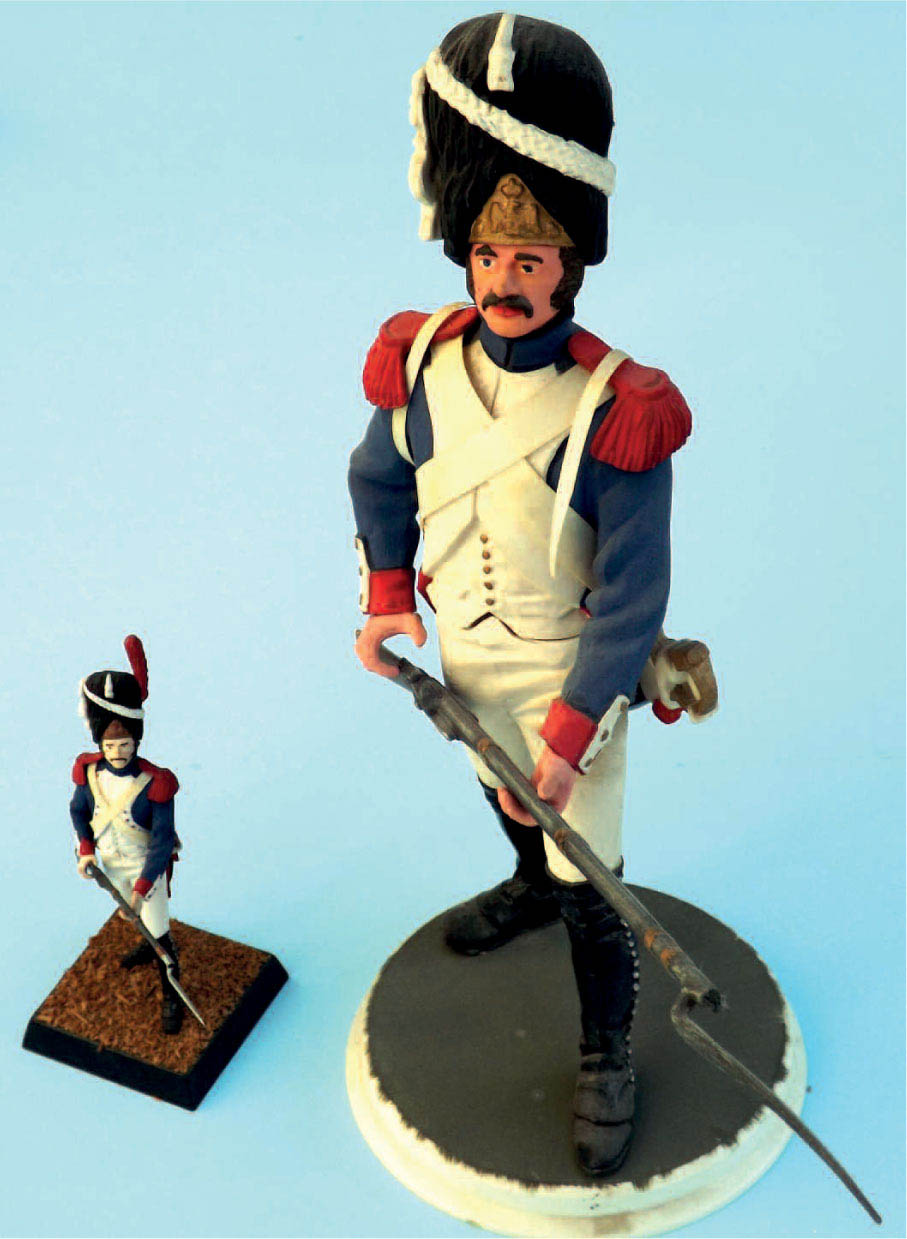
French Grenadier models of 1973 (left) and 1977 compared.
The Focke-Wulf was Airfix’s first attempt at the early Fw190 variants. A good model, it was finally replaced by a new tool in 2013. The Westland Whirlwind was the replacement for the old 1958 kit and was a vast improvement, but is not currently available.
The Skyray, Henschel and Viking were all new to the range. The Henschel was briefly re-released in the 1990s, but otherwise these have not been seen for many years.
Airfix announced a new range of 1:48 scale aircraft. This scale was very popular in the United States, where it was also known as ‘quarter scale’. The models chosen to launch the range were very famous aircraft, although the first didn’t appear until 1979. The Mosquito was originally intended to be modelled to 1:24 scale, but Airfix abandoned it when the costs escalated too much. Hornby launched a 1:24 Mosquito in 2009 to show that Airfix was back!
The Spitfire and Mosquito both had extra parts added over the years to make further versions. The Spitfire was replaced by an all-new kit in 2014.
The USS Forrestal was a replica of the first big US aircraft carrier. It has appeared occasionally over the years. Suffolk and Prinz Eugen were additions to the 1:1200 Waterline Warships range, which was themed around the hunt for the Bismarck. The range of 1:1200 kits was unavailable for years until Hornby released them all in a ‘Sink the Bismarck’ set in 2011.
The Golden Hind was the large-scale version of the original Airfix kit produced in the early 1950s. It was moulded to 1:72 scale and featured crew figures. The box-top painting was by Geoff Hunt, who had replaced Brian Knight as the main painter for the large sailing ships. Geoff Hunt would later become famous for painting the covers to the Patrick O’Brian novels about Jack Aubrey, played by Russell Crowe in the film Master and Commander.
The Bengal Lancer was the second and last of the 54mm kits to be produced at 1:12 scale. Three more 54mm were announced covering the English Civil War. The mounted figure was cleverly designed so that either a Cavalier or Roundhead figure could be completed. They were out of production for many years, but in 2007 were all released in an ‘English Civil War Collection’, which included two mounted figure kits to enable all the options to be modelled.
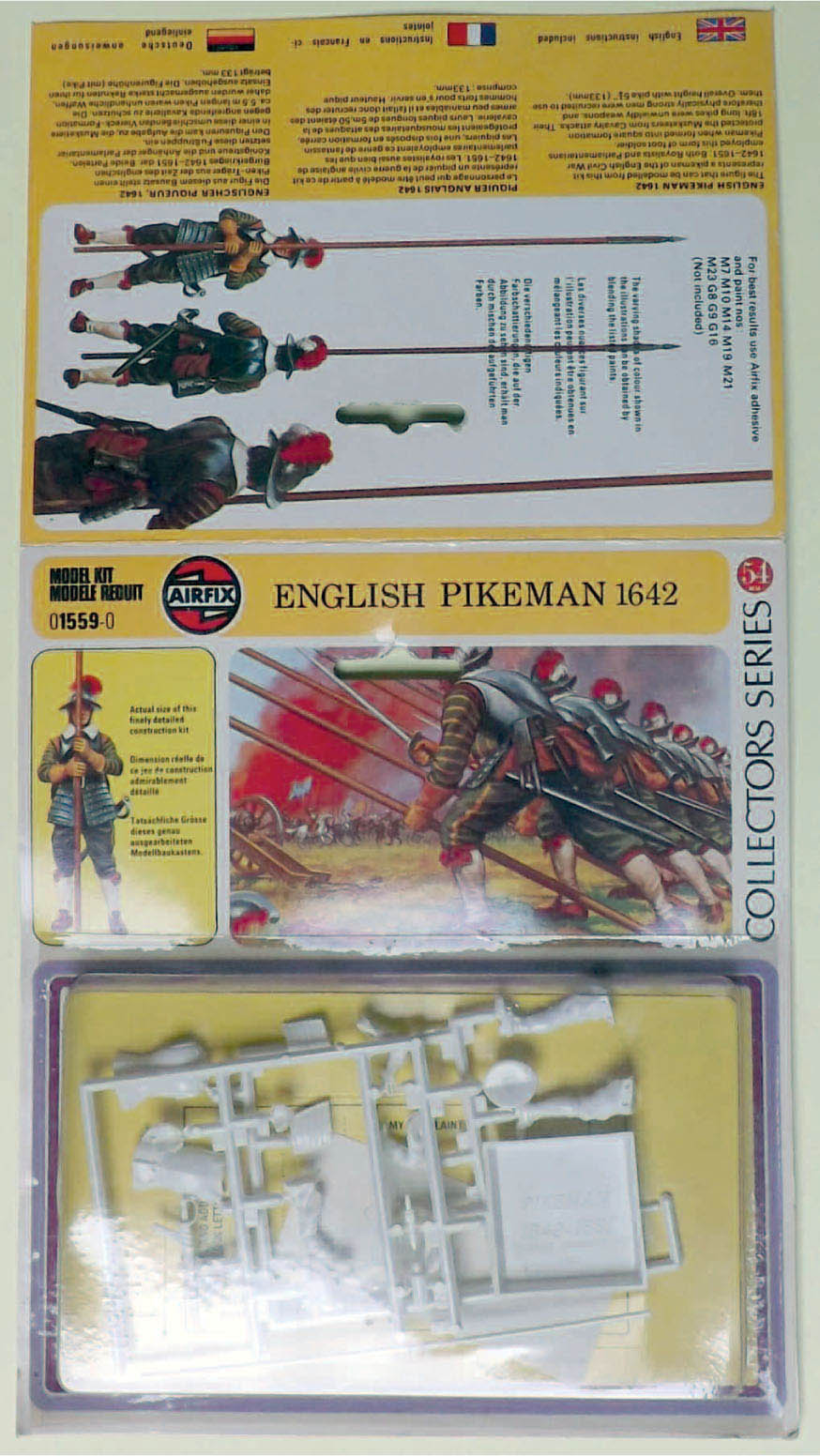
From the Collector’s Series, ‘English Pikemen 1642’ from 1977.
Three more sets of Multipose figures were listed, and like the first two sets, were very well detailed. The second of the Wildlife kits was issued, being a model of a pair of Blue Tits. An exciting new range of kits for younger modellers was announced with the release of two kits of Dinosaur models. They were all to different scales. Thirty years later, six were released again in two sets of three models.
The 1:32 scale soldiers saw the addition of a set of Gurkhas and, surprisingly, a set of Modern German Infantry. Quite who the Germans were meant to fight I do not know, but they were very well moulded. They have not been seen for many years.
Finally in 1:76 scale, a scaled-down Jungle Outpost kit was revealed which included a vacuum-formed base. A second-edition set of British Commandos replaced the original 1968 set. Unfortunately the tool appears to have been lost, as the original tool is the one that is in use today.
A total of thirty new kits was announced in 1978, and twenty-five new kits were released:
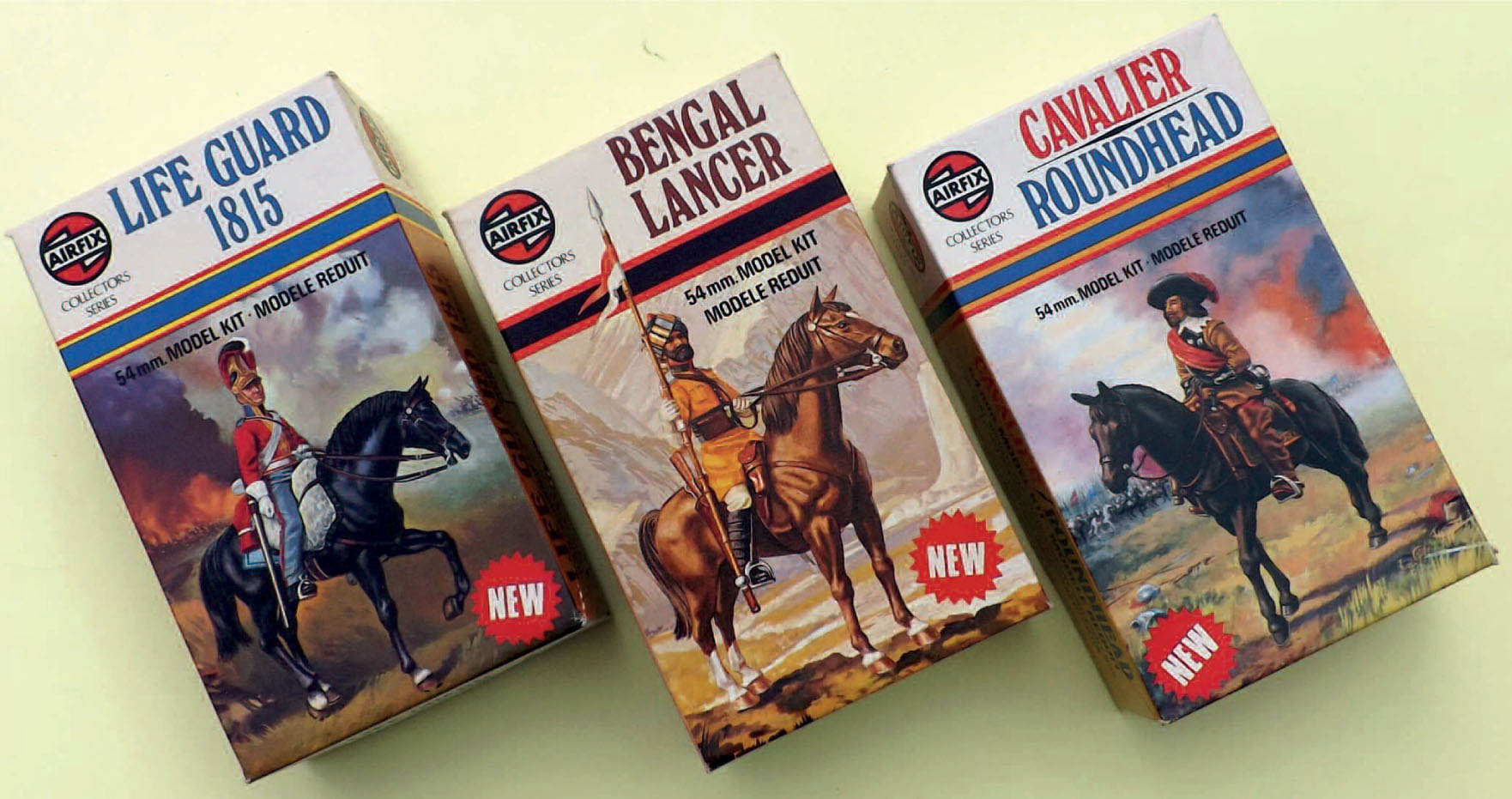
Three Collector’s Series kits from 1978.
01064 |
Focke-Wulf Fw 190D |
1:72 |
01065 |
Supermarine Spitfire Mk Ia |
1:72 |
01068 |
MBB BO 105C Helicopter |
1:72 |
02049 |
Junkers Ju 87B-2 Stuka |
1:72 |
02065 |
Boeing Sea Knight Helicopter |
1:72 |
02066 |
North American P-51B Mustang |
1:72 |
02067 |
Hawker Hurricane Mk I |
1:72 |
03030 |
Junkers Ju 87B/R Stuka |
1:72 |
04022 |
Dassault Mirage F.1C |
1:72 |
05015 |
F-15A/B Eagle |
1:72 |
06177 |
McDD DC10-30 |
1:144 |
10170 |
Space Shuttle |
1:144 |
05175 |
Pan-Am Orion 2001 |
N/A |
07170 |
Starcruiser 1 |
N/A |
06404 |
Stutz Bearcat |
1:25 |
08440 |
1932 Chrysler Imperial |
1:25 |
04585 |
World War II British Infantry |
1:32 |
04586 |
World War II US Infantry (Europe) |
1:32 |
08369 |
Dodge 3/4-ton Ambulance |
1:35 |
08370 |
Steyr Tractor and Nebelwerfer |
1:35 |
08371 |
US Army 2.5-ton Truck |
1:35 |
04382 |
North African Outpost |
1:76 |
05281 |
RAF Rescue Launch |
1:72 |
04380 |
Robins |
1:1 |
03802 |
Ankylosaurus |
N/A |
03803 |
Stegosaurus |
N/A |
03804 |
Corythosaurus |
N/A |
03805 |
Dimetrodon |
N/A |
01756 |
Waterloo Prussian Infantry |
1:76 |
51474 |
Medieval Foot Soldiers |
1:32 |
The Focke-Wulf and two Stukas were designed to replace the 1950s models. The two Stuka kits were separate moulds, but the Series 3 kit contained extra parts to make the ‘R’ version, along with two sets of decals. Both have appeared regularly over the years.
The Mustang, Spitfire and Hurricane were all early versions of the existing Airfix kits and did not replace them. In 2010, Airfix produced a new Spitfire Ia, and an early Mk I Hurricane was released late in 2013. The Spitfire was similar to the 1974 Mk Vb, and it has been suggested that it is the top-selling Airfix kit of all time.
The BO 105C was a new helicopter to the range, but the Sea Knight was a revision of the old Vertol 107-11 from 1965.
The Mirage F.1C and F-15A/B Eagle were models of two new aircraft. The F-15 was later upgraded to the F-15E Strike Eagle in 1993. Both are currently out of production.
Two new 1:144 kits were revealed: the DC10-30 was first issued in British Caledonian markings; and the Space Shuttle was reissued for the twenty-fifth anniversary, and was in the range until 2014.
Two ‘sci-fi’ kits were added: the Orion was a re-issue of the 1969 kit, and the Starcruiser was one of a small range of Airfix-designed ‘sci-fi’ kits. The Orion was sold as a ‘SNAPnglue’ kit in 1981 and released as recently as 2000.
The third kit in the range of 1:72 fast patrol boats was revealed as the RAF Rescue Launch. It is currently in the range again. Airfix was well advanced with plans to make a US PT boat and a replica of the Fairmile ‘D’ fast patrol boat, but sadly these were cancelled shortly before Airfix went under.
Two more 1:25 cars were introduced from MPC moulds: the Stutz Bearcat and Chrysler Imperial. A further three ex-MAX 1:35 AFV kits were listed, but although decals, instructions and boxes were prepared, I don’t think they were ever released by Airfix.
What were to be the final two multipose kits, the British and US Infantry sets, were released. Possibly poor sales put paid to future sets, but I would have loved to have seen sets of Napoleonic figures produced in the multipose format.
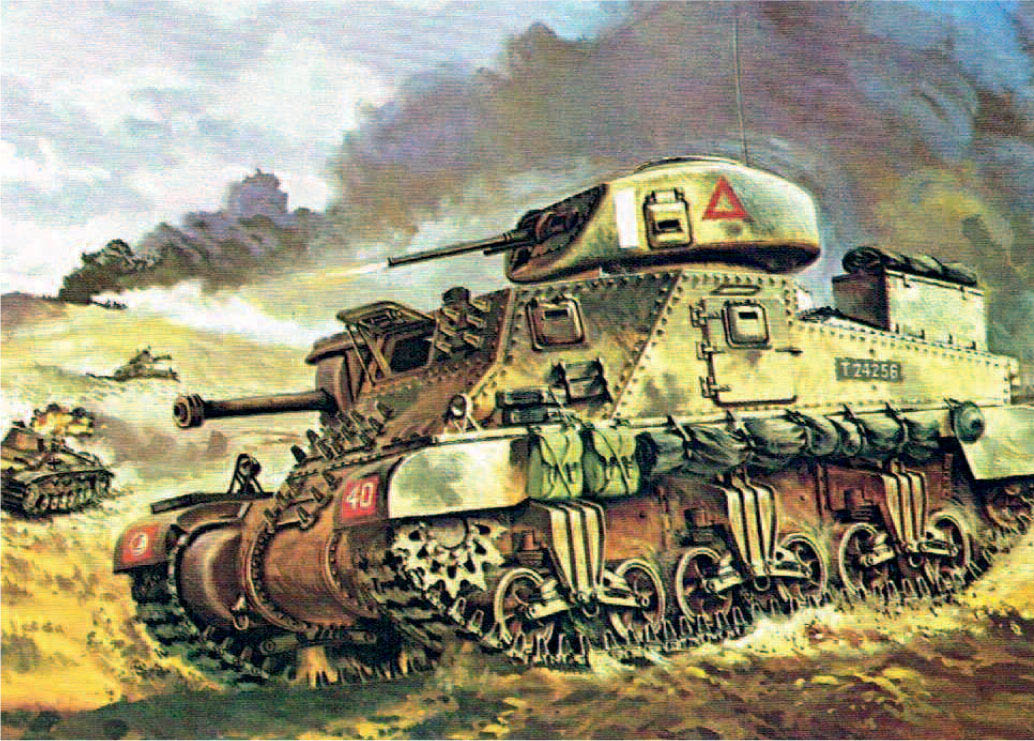
Grant Tank box art from 1978.
The 1975 Desert Outpost was scaled down to 1:76 scale and issued as the North African Outpost with a vacuum-formed base. Recent releases of the 1:76 buildings have not included the bases. A set of Waterloo Prussian Infantry increased to nine the number of Waterloo figure sets in 1:76 scale. They were last issued in the 2008 Waterloo Battle Set. Also released and using the same box illustration was a new set of US Marines to 1:76 scale. They were not advertised. A similar new set of Foreign Legion figures had earlier been released, probably in 1972, and again used the existing illustration. It was by chance that I discovered these new sets.
For the latest set of 1:32 figures, Airfix moved from the safe option of World War II soldiers to produce a set of medieval men-at-arms. They were reissued briefly in 1995 in a bag of six figures.
A pair of robins became the third set of British birds to be announced, and four more dinosaurs joined the first two prehistoric monsters.
It was also announced that as from the October 1978 issue of Airfix Magazine, Gresham Books would take over the publication of the magazine. PSL, which had been printing Airfix Magazine for eleven years, would continue to publish its range of modelling books, but there would be no more books published in conjunction with Airfix.
1979
In 1979 only nine new kits were announced, although some twenty-five were actually released, which reduced the backlog. The new releases consisted of the following:
03035 |
Alpha Jet |
1:72 |
04023 |
McDonnell F2H Banshee |
1:72 |
08173 |
Braniff ‘Big Orange’ Boeing 747 |
1:144 |
10171 |
‘Moonraker’ Space Shuttle |
1:144 |
09259 |
HMS Bounty |
1:87 |
20480 |
Norton ‘Commando’ |
1:8 |
20481 |
BMW R75/5 |
1:8 |
02315 |
Opel Blitz and Pak 40 Gun |
1:76 |
03651 |
Platform Figures |
1:76 |
The Alpha Jet and Banshee were both new moulds. The Alpha Jet, which was the main competitor to the BAe Hawk, has been issued occasionally over the years, but the Banshee has not been seen for many years. The Banshee was apparently chosen for production instead of the Sea Vixen, probably with an eye on the US market.
The ‘Big Orange’ 747 was the standard 747 kit but with Braniff’s unusual orange scheme applied. The kit was known at Airfix as the ‘Big Banana’ because the illustration appeared to show the fuselage curved like a banana! The ‘Moonraker’ Space Shuttle was a version of this space craft, which featured decals to match the ones used in the James Bond film of the same name. As a film tie-in, it had a brief life, but of course the Space Shuttle was unaffected by this.
HMS Bounty was to be the last of the large sailing ships produced by Airfix. It was noted by the designers of the kit that the hull shape and dimensions were very close to those of the Endeavour, Airfix’s first large sailing ship kit. Work on a replica of the Santa Maria was well advanced, but it was cancelled as the financial situation worsened.
The two motorcycles were produced from moulds purchased from Heller. Two variants would follow in 1980, but none is currently available.
The Opel Blitz and Pak 40 Gun was a decent model of the German World War II combination. It is the only one of the 1980 introductions which is still in the catalogue.
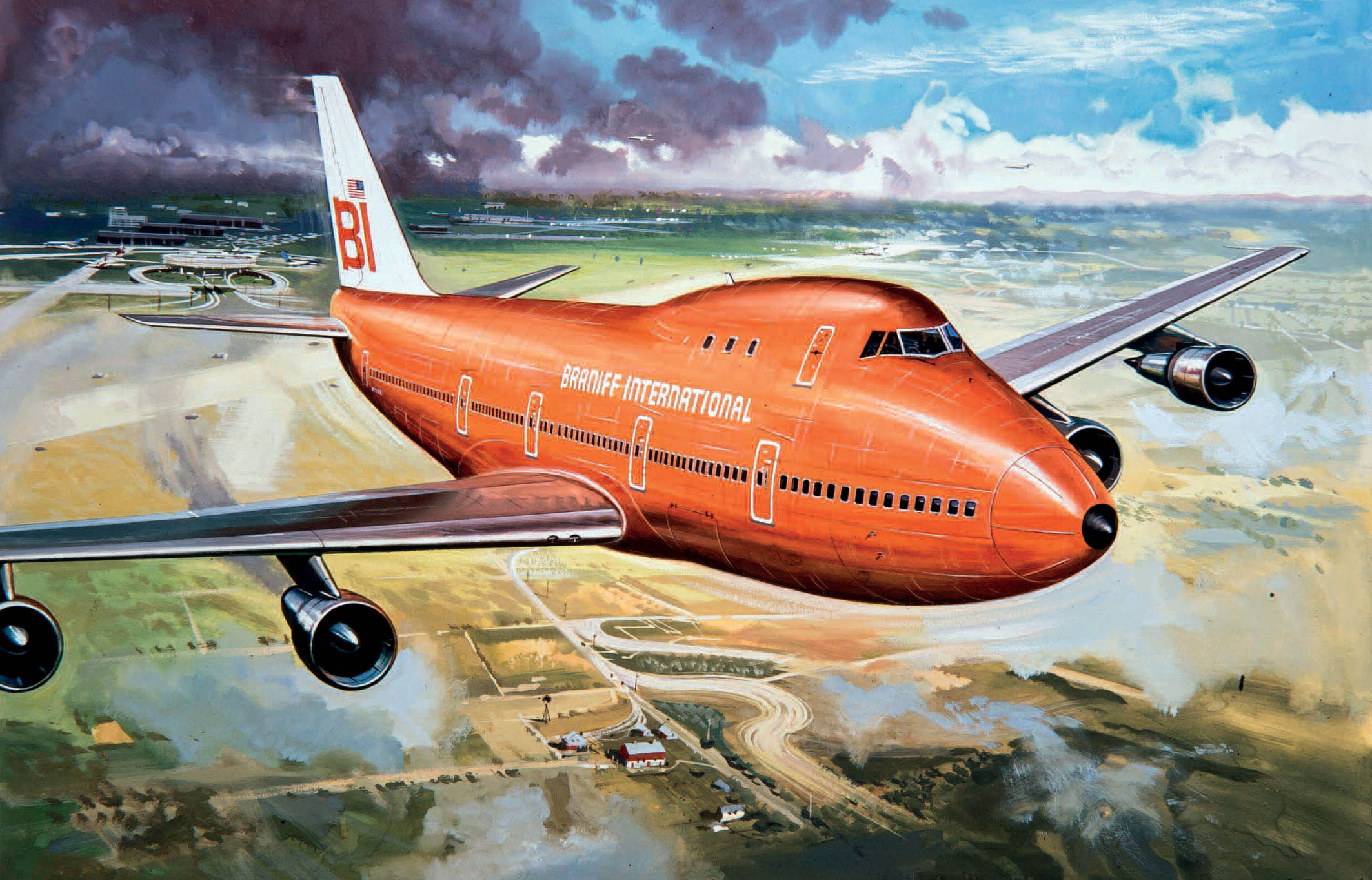
The 1979 Braniff ‘Big Orange’ Boeing 747 kit. AIRFIX
Finally, Airfix released the first of two sets of figures to go with its new Train sets and existing Trackside kits. The two sets were later sold to Dapol, which company produces them today.
The big news for 1979, however, was the decision to rotate many of the older moulds. A great many shops found they could not stock the entire range of Airfix kits as there were simply too many of them. Some older kits were advertised in the catalogue each year but were not actually issued at that time.
So Airfix decided to withdraw many of its older kits to leave a core range, and then rotate the withdrawn moulds on a three-year cycle. This immediately reduced the number of kits in the range and meant that when models did return they could receive new colours and squadron markings. Virtually all the existing kits had for the previous twenty years used the same decals and colours. Airfix referred to these re-released kits, including the non-aircraft kits, as ‘new squadron’ releases.
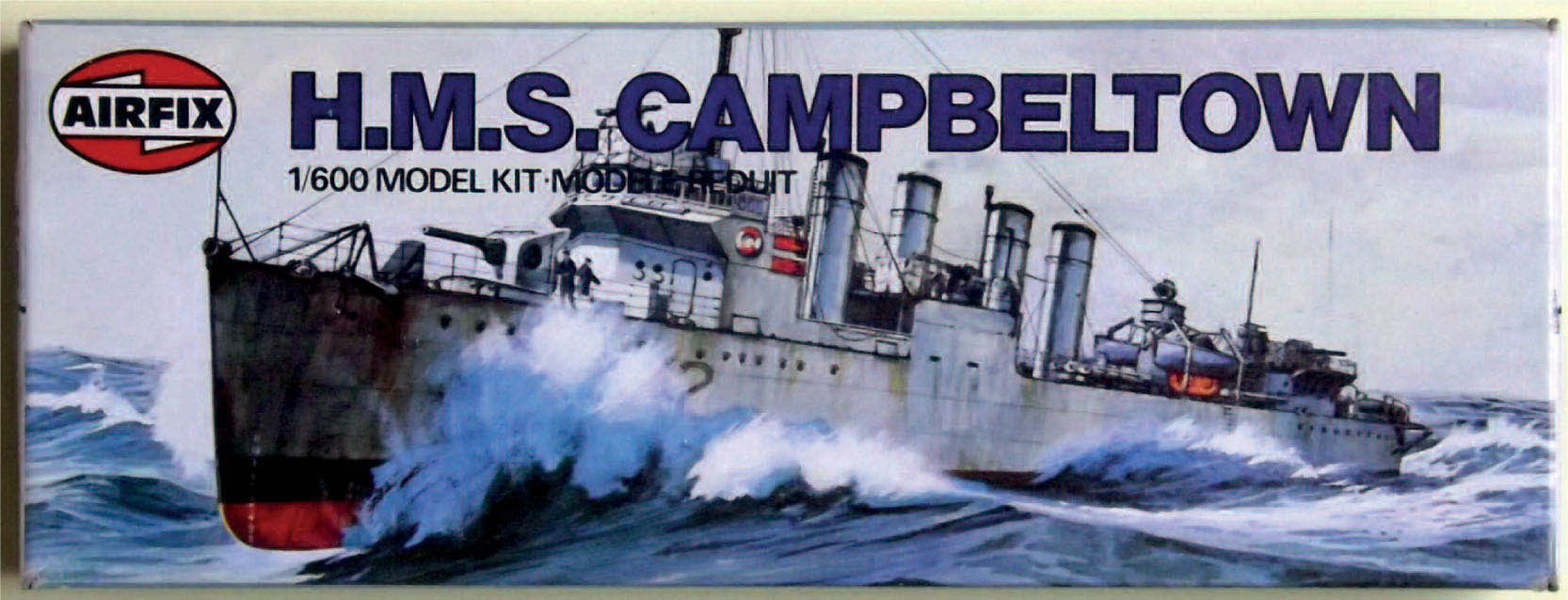
Geoff Hunt’s artwork for the 1979 release of the HMS Cambeltown model. Cambeltown was the destroyer packed with explosives and then deliberately crashed into the dry dock at St Nazaire in the daring raid of 28 March 1942.
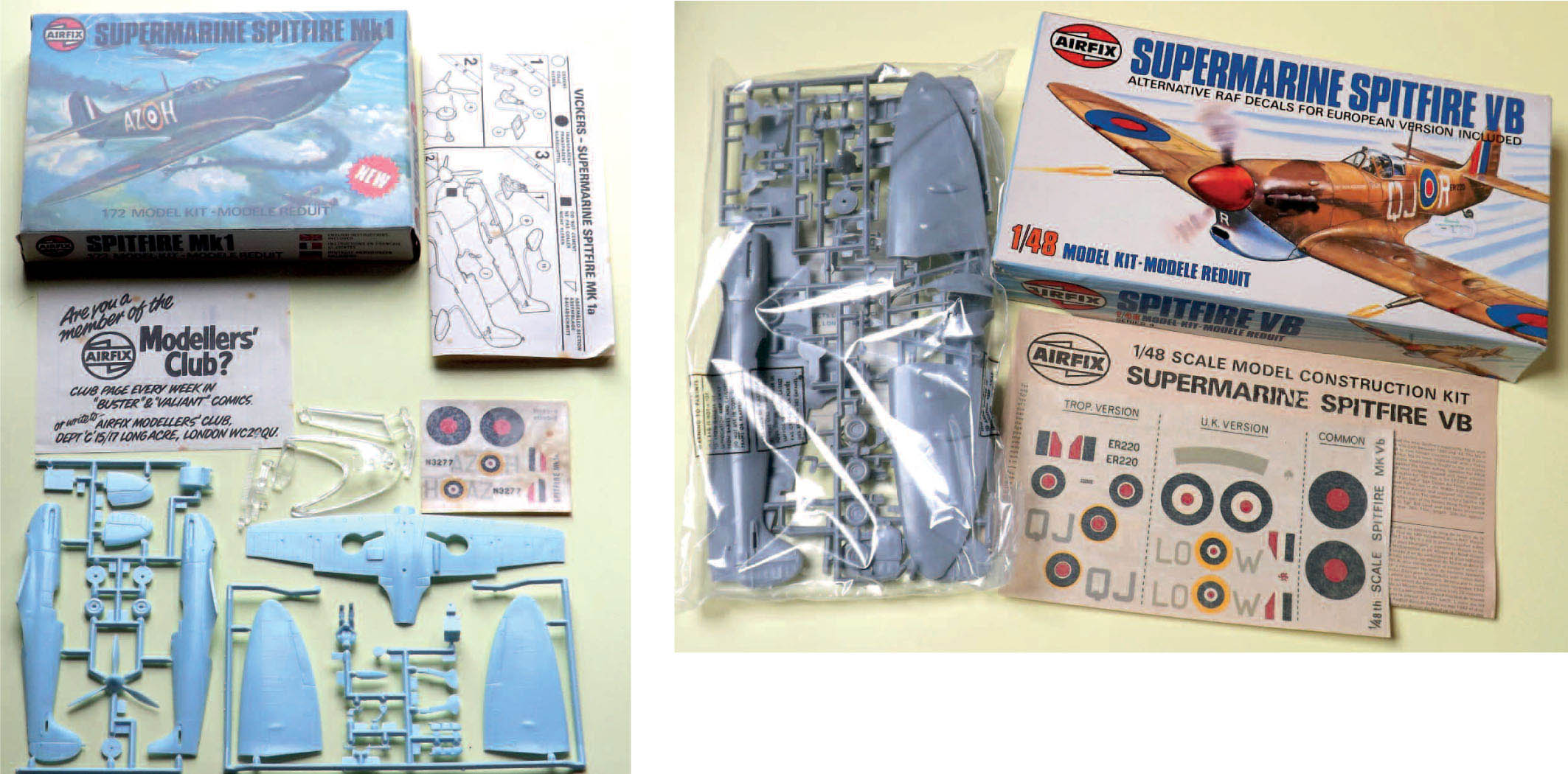
Spitfire Mk Ia and Mk VB kits, 1979.
The change of markings meant that the existing illustrations could not be used, so the likes of Ken McDonough and Ron Jobson would repaint the box tops for a ‘new squadron’ release. Thereafter it has been the policy of Airfix to offer a core range of kits each year, with certain kits making a come-back for a short period. Some kits turn up regularly, but others disappeared from the range for twenty or more years, or have not yet reappeared.
Thus 1979 was not a very exciting year for Airfix modellers, although the release of many of the previous year’s new models would keep most of them happy.
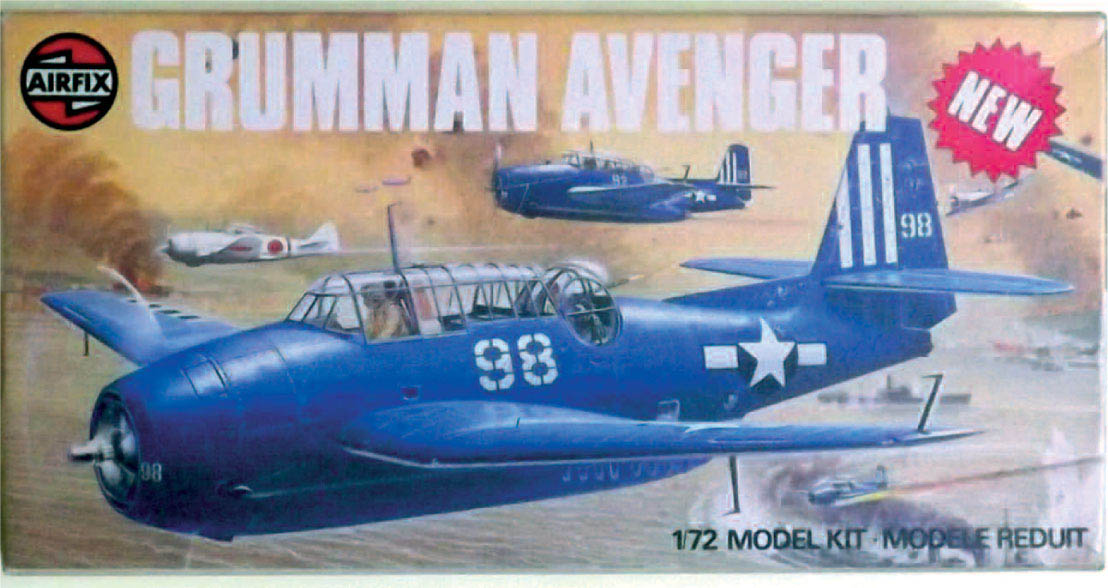
Grumman Avenger box from 1979.
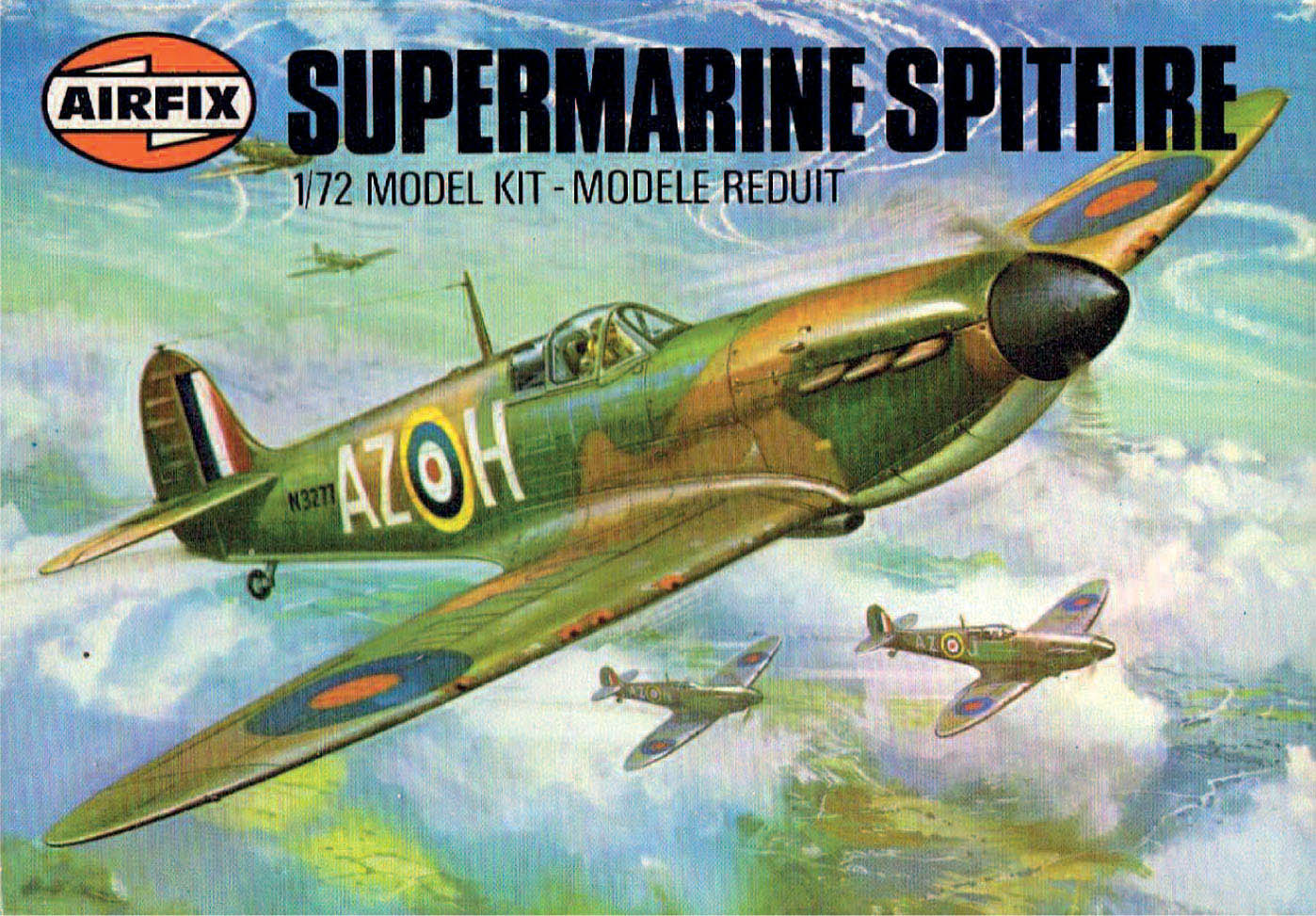
Ken McDonough’s Spitfire Mk.1a artwork from 1979.
1980
Things looked up in 1980, when thirty new kits were announced and thirty-three were released. The new additions were as follows:
03036 |
MiG-23 Flogger |
1:72 |
08002 |
Avro Lancaster BIII |
1:72 |
04102 |
Hawker Hurricane Mk I |
1:48 |
04103 |
Hawker Fury Mk I |
1:48 |
16001 |
Focke-Wulf Fw 190A-8/F |
1:24 |
06179 |
McDD DC10-30 – (SAS) |
1:144 |
05174 |
Starcruiser Interceptor |
N/A |
08175 |
Cosmic Clipper |
N/A |
06405 |
Lancia Stratos |
1:24 |
06406 |
Triumph TR7 |
1:24 |
06407 |
Ferrari 365 Boxer |
1:24 |
06408 |
Porsche 934/5 |
1:24 |
06409 |
Datsun 280Z |
1:24 |
06410 |
Mustang Cobra II |
1:24 |
06412 |
Lamborghini Countach L500S |
1:24 |
07401 |
Maserati Merak |
1:24 |
07402 |
Lotus Elite |
1:24 |
07404 |
BMW M1 Coupé |
1:24 |
16401 |
Ford C900 Tractor and 40in Trailer |
1:32 |
20482 |
Norton SS |
1:8 |
20483 |
BMW Polizei |
1:8 |
06361 |
17-Pdr Anti-Tank Gun and Crew |
1:32 |
51494 |
World War I British Infantry |
1:32 |
51575 |
World War II British Infantry |
1:32 |
51576 |
World War II Italian Infantry |
1:32 |
51514 |
Sherman Tank |
1:32 |
01757 |
World War II Italian Infantry |
1:76 |
03628 |
Railway Workers |
1:76 |
04831 |
Kingfisher |
1:1 |
03806 |
Pteranodon |
N/A |
The ‘Flogger’ was a nicely detailed model of the then current Russian fighter, but it has not been seen for a few years. The Lancaster was the eagerly awaited replacement for the first of Airfix’s large aircraft kits released in 1958. It was a magnificent model, and over the next thirty years would also be sold as a Dambusters and Grand Slam variant. Despite recent releases from other manufacturers, it was still considered superior in some areas. In 2013, in time for the seventieth anniversary of the Dambusters raid, a brand new tool was released: it is so far available in Dambusters, BIII and BII variants. It is an exceptionally fine model, and now also appears in the Battle of Britain Memorial Flight sets.
A good replica of the Hurricane Mk I joined the 1:48 range, and is still in production today. In 2015, Airfix is to release a new Hurricane Mk I. The Hawker Fury was an unfinished mould that was bought from Merit and then finished by Airfix. It is the only pre-World War II aircraft in the 1:48 range, and was still in the catalogue in 2014.
The Focke-Wulf Fw 190A-8/F was the last of the 1:24 superkits to be designed by Airfix before the 1981 closure. It was slightly simplified but had very good surface detail. It is still in the catalogue in 2014, but now has an Adam Tooby box top.
The DC10 was an accurate replica of the TriStar’s main rival, and the kit has been released regularly over the years. Two sci-fi kits were released, but these only had a short life.
Airfix had bought the moulds for around a dozen Japanese-designed car and lorry kits, and released them as a fairly economical way of expanding the range. They were later released by Humbrol. Two further 1:8 motorcycles were released using the moulds previously bought from Heller.
One of the most exciting kits to be announced was a 1:32 scale model of the famous British 17-pounder field gun. It was a highly accurate model and came with a set of figures to fire it. Unfortunately, due to budget restrictions, a set of British Infantry multipose figures was included rather than specially designed figures. This tended to show the versatility of the ‘multipose’ concept, as the parts could be used to make gunners for the kit. However, it was still a very nice model which is today sought-after due to its comparatively short production life. Airfix had exciting plans for new 1:76 and 1:32 AFVs and tanks, but again the deteriorating financial position meant that work on them was stopped or slowed right down.
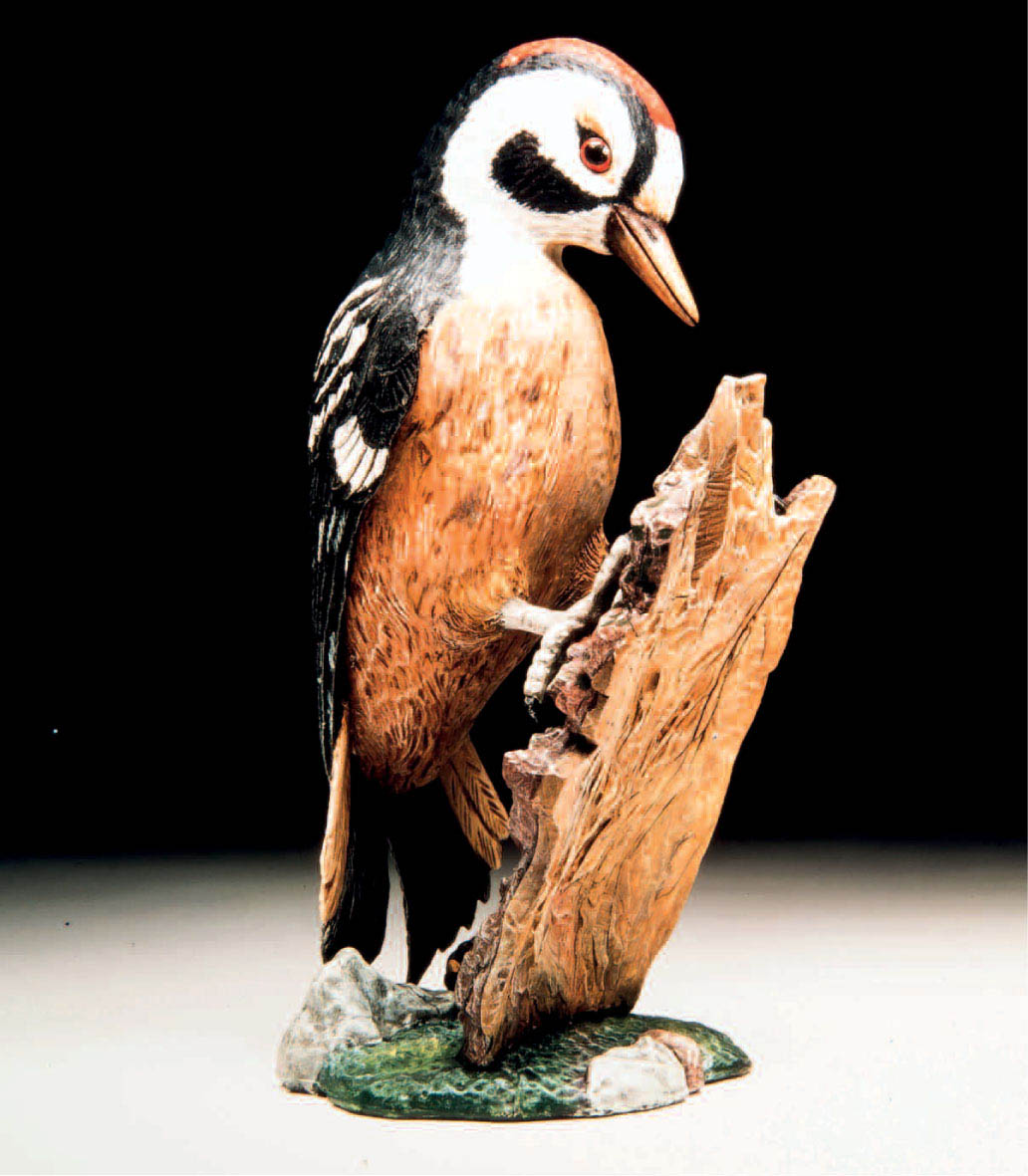
1980 Lesser Spotted Woodpecker kit. AIRFIX
A long-awaited set of World War II British Infantry was released alongside a set of Italian Infantry in 1:32 scale. The first of what was expected to be the up-scaling of the 1:76 World War I figures was announced but never actually released; I don’t think they were ever tooled. The Italians were also released at 1:76 scale and these are still available today.
The Railway Workers was the second set of railway figures to be released at this time by Airfix, and there were plans to release all the train and Trackside kits in 1981 – but as we now know, this was not to happen.
The Sherman Tank was the latest in the range of ‘polyprop’ 1:32 AFVs, but was not released by Airfix. It was later released by Classic Toy Soldiers in the US, for which company it was manufactured by Humbrol.
A ‘life-size’ kit of the kingfisher bird was added to the range. Since it was larger than the other birds, only one bird was included, but there was a nice log with a fish in the bird’s mouth to make a mini diorama.
For dinosaur enthusiasts a model of the pteranodon joined the small range of dinosaur models.
This was an interesting selection, but not so great once the purchased moulds are removed. However, there were some very expensive tools in there, which showed that Airfix was still committed to developing its large kit range. The payback time for tool costs was increasing alarmingly and many small kits would now require several years, even decades, to reach profitability – a far cry from the heady days of the 1950s and 1960s when the initial Woolworth’s order paid for the development cost. The much higher selling price of the large kits meant that the money could be recouped in a much shorter time, but the problem with large kits was that the initial outlay was considerably higher, and reduced cash flow meant that they couldn’t always be produced.
Had Airfix survived the events of 1981, it is likely that several of these kits might still have not repaid their tooling costs by today, such is the effect of the downturn in the kit market that was starting to appear in the late 1970s. However, it would have had a back catalogue of 500 to 600 ‘paid for’ kits to sustain it and generate money for new models.

17-Pounder gun and crew kit from 1980.
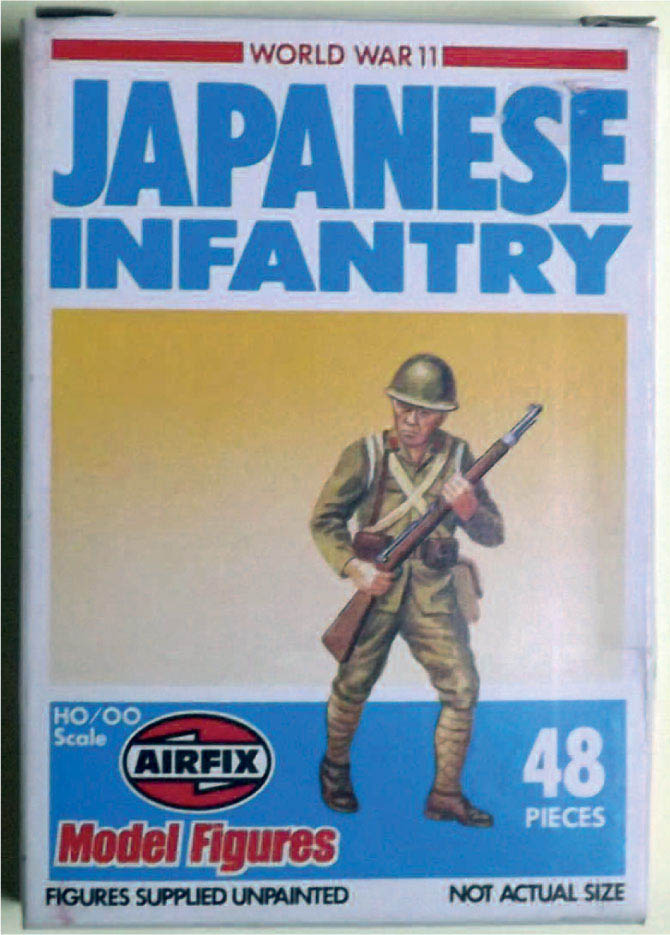
Type 6 box of Japanese infantry figures, 1980.
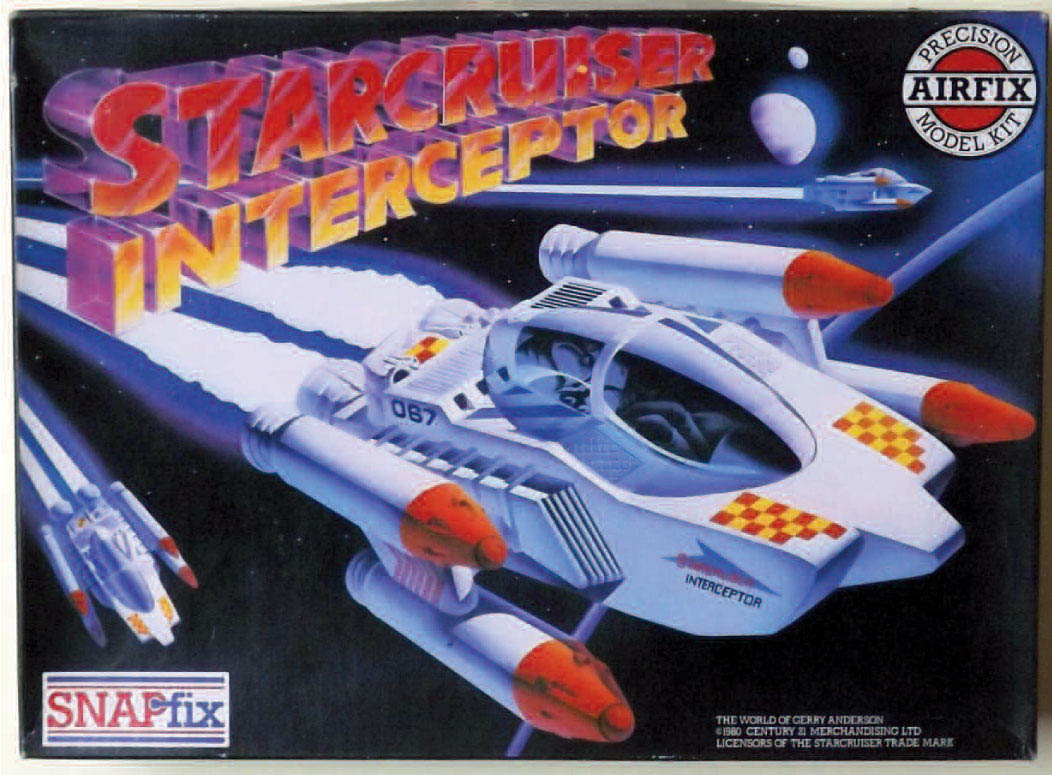
1980’s Starcruiser Interceptor SNAPnglue kit.
1981
A thinner catalogue devoted to 1981’s new releases was produced, but very few were distributed before Airfix went into receivership during the January 1981 Toy Fair: a cruel irony. Forty models were announced, but twenty-four were cars or vehicles produced from moulds either bought by Airfix or ‘polybagged’ in.
04024 |
McDD F-18A Hornet |
1:72 |
04025 |
F-16A/B Fighting Falcon |
1:72 |
06003 |
HH-53C Super Jolly Green Giant |
1:72 |
06004 |
CH-53G/CH-53D Helicopter |
1:72 |
05100 |
Junkers Ju 87B Stuka |
1:48 |
16001 |
Focke-Wulf Fw 190A-5 |
1:24 |
06205 |
HMS Repulse |
1:600 |
96206 |
HMS King George V |
1:600 |
01758 |
NATO Ground Crew |
1:76 |
51577 |
Space Warriors |
1:32 |
04382 |
Lesser Spotted Woodpecker |
1:1 |
06360 |
Little Owl |
1:1 |
04800 |
Brontosaurus |
N/A |
09174 |
Cosmic Starship |
N/A |
04213 |
Nautilus |
N/A |
04401 |
Kansas Kruiser |
1:32 |
04402 |
Night Prowler |
1:32 |
04403 |
Krackle Kat |
1:32 |
04404 |
Rebel Rouser |
1:32 |
14401 |
Ford C-800 Truck |
1:32 |
04851? |
Orange Tip Butterfly |
1:1 |
04851? |
Peacock Butterfly |
1:1 |
06413 |
Maserati Bora |
1:24 |
06414 |
Mazda RX7 |
1:24 |
06415 |
Porsche 935 Turbo |
1:24 |
06416 |
Turbo Firebird |
1:24 |
06417 |
Turbo-Vette |
1:24 |
06418 |
Mustang Cobra |
1:24 |
06419 |
Camaro Z28 |
1:24 |
06420 |
Firebird Type K Sportwagon |
1:24 |
06421 |
Custom Mustang |
1:24 |
06422 |
Camaro Ultra Z |
1:24 |
06423 |
Custom Corvette |
1:24 |
06424 |
Renault Alpine |
1:24 |
06425 |
Maserati Boomerang |
1:24 |
06426 |
BMW 3.5 CSL |
1:24 |
06427 |
De Tomaso Pantera |
1:24 |
07406 |
Datsun 280ZX |
1:24 |
I did not acquire my copy of the catalogue until nearly twenty years after, and today copies of the 1981 catalogue are very hard to come by.
The four new 1:72 aircraft kits were very attractive replicas of the latest US Air Force and Navy combat aircraft. The two fighters would be upgraded and new decals added over the years. The two large helicopters were in fact one mould that was released as two separate variants. It was part of the new policy to maximize the returns on a new mould. In the past Airfix had tended to mould one variant of an aircraft or tank; now they would be able to sell two models from the one mould. In recent years, Hornby has tooled up a basic mould to make a particular aircraft and then produced smaller tools to make further variants. It is a very cost-effective idea and means that multiple variants can be sold at relatively little extra cost.
As mentioned earlier, the main problem facing Airfix was that the time taken to recover the mould cost had increased dramatically, and the number of kits produced at each production run was steadily falling. Where once it had taken just a year or so to recoup the cost of production, now it was slipping into years and sometimes decades.
The Stuka was the latest in the new range of 1:48 aircraft kits, and was a very fine model that had benefited from the work done on the 1:24 kit. It would not be released until after the Palitoy takeover.
The Focke-Wulf Fw190A kit had been released just before Christmas, but was officially unveiled in the new catalogue. It is often regarded as Airfix’s ‘swan song’ – and not a bad one at that.
Airfix had not been producing many new 1:600 warships, but surprised us all by announcing the introduction of fine models of HMS King George V and HMS Repulse, both involved in the Bismarck chase. Plans to release a model of HMS Sheffield were scuttled at the last moment. Again the ships would not be released until after Palitoy took over.
The OO/HO range of figures would see an attractive set of modern NATO Airfield Personnel added to the range to join the three earlier World War II sets. There was no mention of the 1:32 World War I British Infantry, but in their place was a set of Space Warriors. These figures seemed to be based on 1940s and 1950s sci-fi characters, and even included a female warrior in a short skirt! They have only appeared briefly once since, when Humbrol released six figures in a bag.
Two more single birds and a dinosaur kit were introduced. The bird kits have not been produced since the early 1980s, although they have been released by Gunze Sanyko in Japan on two separate occasions.
Along with the Space Warriors, Airfix proposed to release several kits from the realms of fantasy. The Cosmic Starship was an Airfix design, and the Nautilus was based on the ship in the Walt Disney film Twenty Thousand Leagues under the Sea. It does seem a strange choice, but presumably the tooling costs were low and they hoped to sell plenty of kits. It was finally tooled by Palitoy, but it was decided not to release it. Comet Miniatures did release a resin version produced using a test shot; the whereabouts of the mould is not known, but it was probably scrapped.
The four modern cars are interesting. The original kits were of modern cars of the 1960s, but by 1979 they were in a state of limbo, being no longer ‘modern’ but not old enough to be ‘classic’ or ‘vintage’. Humbrol and Hornby have been able to re-release them as they are now considered to be classic cars of the 1960s! Sales were tailing off considerably, so Airfix asked toy designer Graham Westoll to look at ways of making the moulds relevant to the 1980s and thereby squeezing a few more sales out of them. His solution was to convert an initial four kits to ‘hot rod’ or ‘streetwise’ cars with colour schemes and decals to make them ‘cool’. This involved some revision to the moulds, but Airfix felt that the existing kits were ‘dead in the water’ anyway so they had nothing to lose. In the end only three were actually released, and then only for a short while. They command high prices when they do turn up on eBay. They are unlikely to be re-released, but you never know.
Finally from its own moulds, Airfix proposed to release kits of butterflies to go with its bird kits. A swallow was under way, and artwork was prepared for a red squirrel. The moulds for the butterflies and their transparent wings were made and are now with Hornby, but the butterflies never emerged from their cocoons.
The rest of the kits were releases of the ex-Japanese tools Airfix had recently acquired. They were also re-released by US Airfix, which produced much needed license income for Airfix.
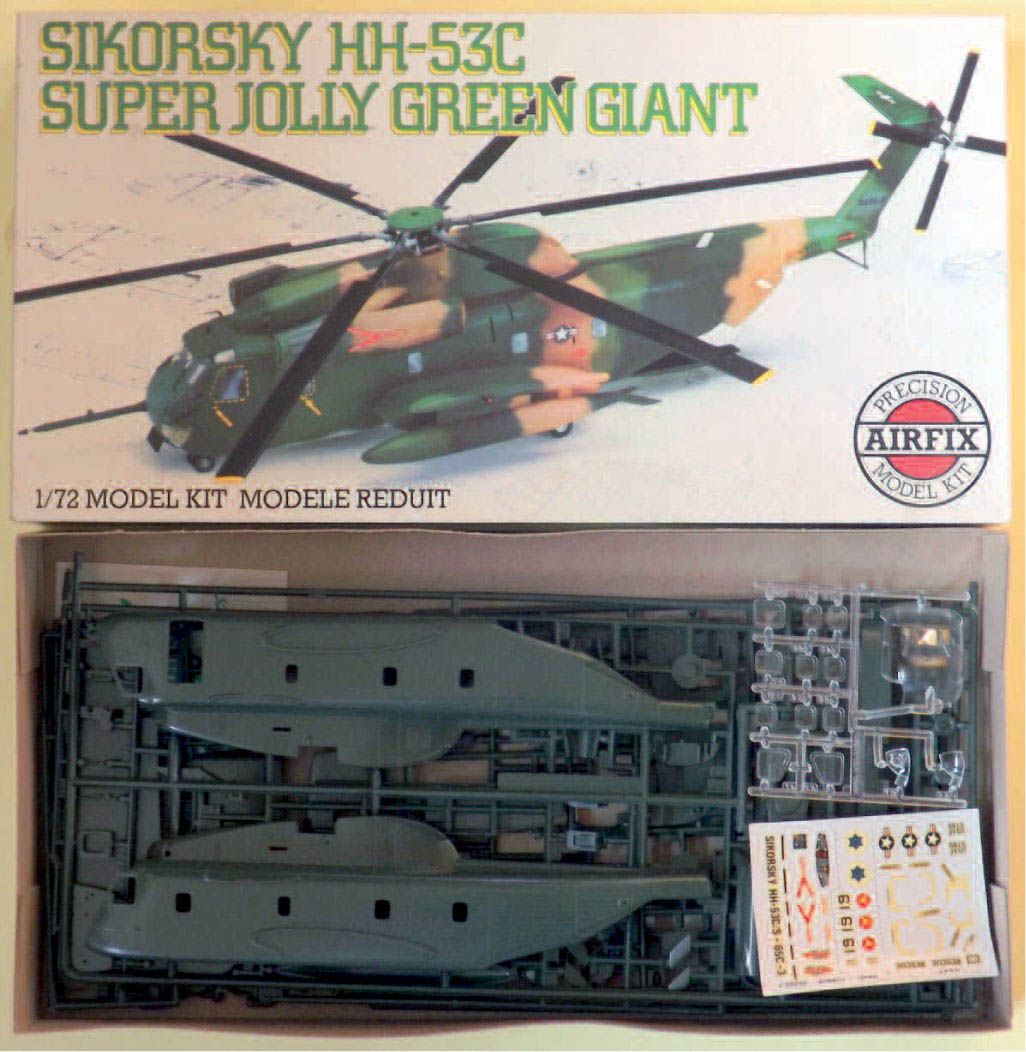
The Jolly Green Giant helicopter kit from 1981.
Following the announcement of the closure of Airfix in late January 1981, things ground to a halt whilst the receiver sought a buyer or buyers. Limited production of kits was authorized, but only those new kits that were actually ready to go were produced. Thus in the first four months we saw several new kits released, but it was clearly up to the new owners to decide which of the other ‘new’ releases would be completed.
Several companies were interested in buying the Airfix kit division, which was still proving to be profitable. A management buyout was proposed, and Peter Allen says that many of the employees got out their chequebooks in anticipation. In the end the receivers announced that the bid from General Mills of the United States had been accepted. Humbrol, which was keen to buy Airfix, was ‘pipped to the post’ but would get another chance in 1986.
Thus the large Airfix company that many of us had grown up with was no more. In the last year or so Airfix had sold its packaging and houseware divisions to help reduce its bank borrowings. Meccano, the losses at which were largely responsible for the poor state of the group’s finances, had also been closed. Palitoy, General Mills’ British subsidiary, absorbed the Great Model Railways into its Mainline range, and later sold the Trackside kits to Dapol, which continues to produce them. Airfix/MRRC racing sets were taken over by MRRC and moved to Jersey. Just as the Airfield Control Tower was the only Trackside kit not sold to Dapol, the Austin Mini was the only modern car kit that was sold to MRRC.
The Arts and Crafts and Toys were closed down, and the licensed toys such as Weebles returned to their license holders, where they are still produced.
I confess that following the January announcement, I largely lost interest in Airfix and stopped keeping records of kit production. The fact that Airfix was now American-owned didn’t help: it was akin to learning that the football team you had eagerly supported from childhood had folded and been sold to the Americans. A large and important chunk of your childhood seemed to be gone forever.
For the next ten years, Airfix kits were not easy to come by. Most of the ‘other’ shops that had sold Airfix kits no longer sold them. Model shops, which were now the only real source of Airfix kits, were reportedly having difficulties obtaining the models, and an increasing number of shops were closing down. It seems that the disappearance of Airfix kits, which had revitalized a lot of toy and model shops in the 1960s and 1970s, was now to lead to their decline. I certainly never saw any Palitoy catalogues until years later.
So nearly thirty years after their first appearance, the kits were still considered the ‘jewels in the crown’ and have continued to be produced ever since. The golden age of Airfix kits had lasted for just over twenty-five years, and we would have to wait another twenty-five for the second golden age to appear.